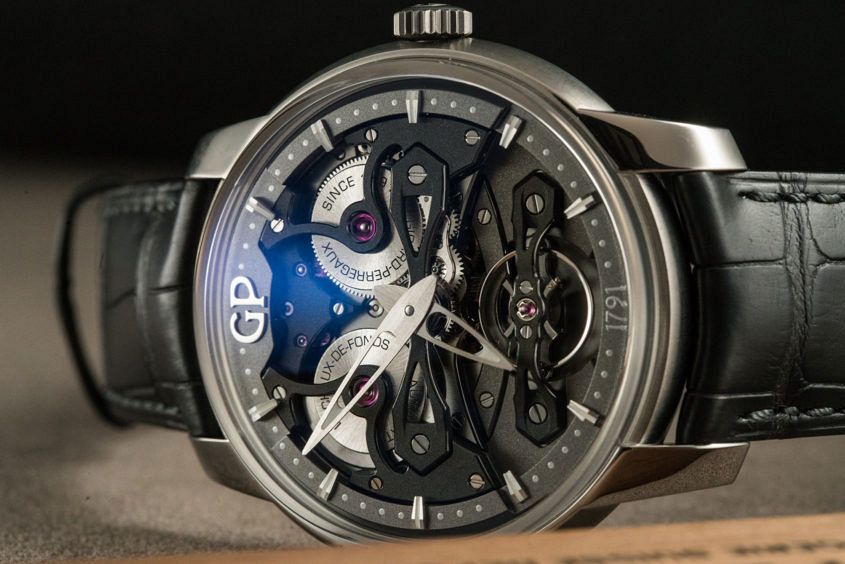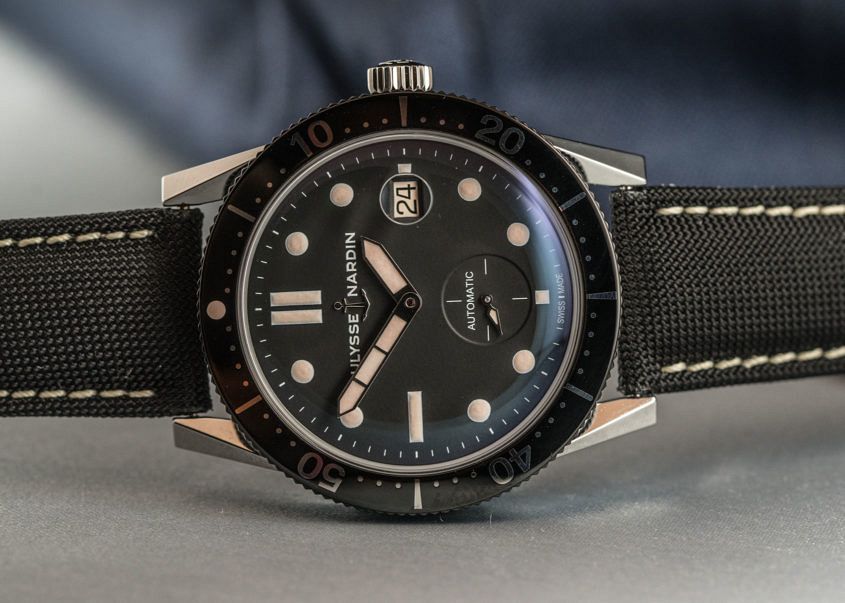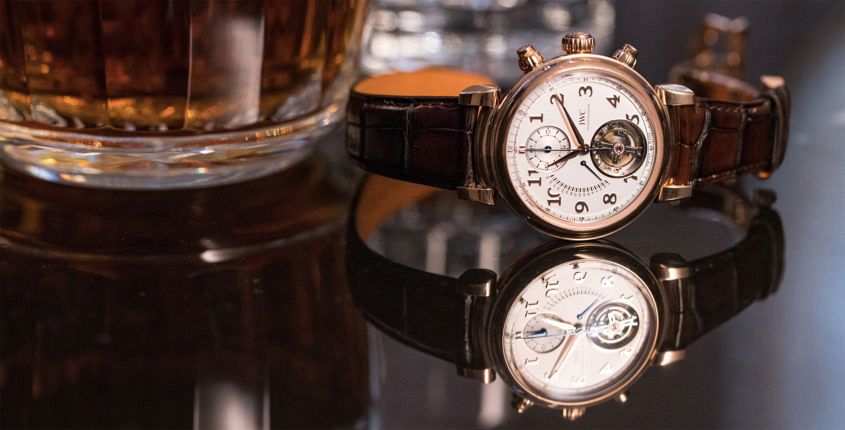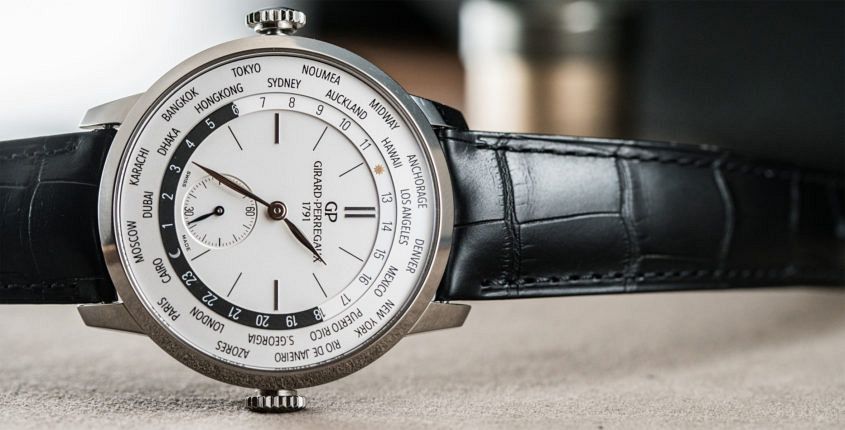INTRODUCING: The Girard-Perregaux Neo-Bridges
 As one of the oldest continuing watch manufacturers in the world, Girard-Perregaux have a long, illustrious history of sharp and innovative designs. In 1889 at the Paris Universal Exhibition, the brand’s legendary pocket watch “Esmeralda”, a tourbillon with three gold bridges, was awarded first prize, establishing the motif as an emblematic design for the brand. Since then, the iconic Tourbillon with Three Bridges has formed the cornerstone of GP’s top tier collection. This year saw the addition of the Neo-Bridges, a “retro-futuristic” take on the design, which embodies the long-standing traditions of the brand while adopting its rediscovered forward-looking approach to watchmaking. Distinctively modern, the dial of the Neo-bridges is fully open-worked and essentially consists of an outer ring with suspended indices and minute markers – laying bare the front side of the newly developed automatic calibre GP08400-0001. However, the movement is anything but bare, with its inner workings showcased in a mixture of matt sandblasted finishes, an NAC-coated mainplate, and a PVD treatment on the hallmark bridges. These bridges span across the dial, with the lower bridge supporting the large, 10.15mm diameter, variable-inertia balance wheel (instead of the familiar tourbillon as seen on other models) – its generous size…
As one of the oldest continuing watch manufacturers in the world, Girard-Perregaux have a long, illustrious history of sharp and innovative designs. In 1889 at the Paris Universal Exhibition, the brand’s legendary pocket watch “Esmeralda”, a tourbillon with three gold bridges, was awarded first prize, establishing the motif as an emblematic design for the brand. Since then, the iconic Tourbillon with Three Bridges has formed the cornerstone of GP’s top tier collection. This year saw the addition of the Neo-Bridges, a “retro-futuristic” take on the design, which embodies the long-standing traditions of the brand while adopting its rediscovered forward-looking approach to watchmaking. Distinctively modern, the dial of the Neo-bridges is fully open-worked and essentially consists of an outer ring with suspended indices and minute markers – laying bare the front side of the newly developed automatic calibre GP08400-0001. However, the movement is anything but bare, with its inner workings showcased in a mixture of matt sandblasted finishes, an NAC-coated mainplate, and a PVD treatment on the hallmark bridges. These bridges span across the dial, with the lower bridge supporting the large, 10.15mm diameter, variable-inertia balance wheel (instead of the familiar tourbillon as seen on other models) – its generous size…
The post INTRODUCING: The Girard-Perregaux Neo-Bridges appeared first on Time and Tide Watches.
 When it was originally conceived, the tourbillon was a technical solution to a specific problem — the impact of gravity on the accuracy of a pocket watch’s movement. These days the whirling cage of finely finished metal represents something else. For brands, it’s a bravura statement of prowess. For watch lovers, it’s typically the crowning piece in a collection, the finest point in fine watchmaking. If we’re honest, the appeal of the tourbillon is only partially due to an appreciation of the watchmaker’s art. There’s also an element of conspicuous consumption to wearing a tourbillon. Dress it up however you like — wearing a watch with a dial-facing tourbillon is a pretty powerful statement. Dig a little deeper into the complication and you’ll discover that not all tourbillons are created equal. TAG Heuer’s vaunted $20k Heuer-02T is CNC printed, and many other brands rely on outsourced, third-party movements. Ulysse Nardin’s Marine Tourbillon avoids these pitfalls and manages to offer one of the most compelling value propositions of 2017. Before we get to the movement, let’s talk about the watch as a whole. The 43mm steel case has modern touches, like the angular, integrated lugs, squared-off crown guard and rubber inset…
When it was originally conceived, the tourbillon was a technical solution to a specific problem — the impact of gravity on the accuracy of a pocket watch’s movement. These days the whirling cage of finely finished metal represents something else. For brands, it’s a bravura statement of prowess. For watch lovers, it’s typically the crowning piece in a collection, the finest point in fine watchmaking. If we’re honest, the appeal of the tourbillon is only partially due to an appreciation of the watchmaker’s art. There’s also an element of conspicuous consumption to wearing a tourbillon. Dress it up however you like — wearing a watch with a dial-facing tourbillon is a pretty powerful statement. Dig a little deeper into the complication and you’ll discover that not all tourbillons are created equal. TAG Heuer’s vaunted $20k Heuer-02T is CNC printed, and many other brands rely on outsourced, third-party movements. Ulysse Nardin’s Marine Tourbillon avoids these pitfalls and manages to offer one of the most compelling value propositions of 2017. Before we get to the movement, let’s talk about the watch as a whole. The 43mm steel case has modern touches, like the angular, integrated lugs, squared-off crown guard and rubber inset… Imagine you were suddenly launched back in time and onto the deck of a naval ship in the second half of the 19th century. What’s the very first thing you’d do? Personally, if I’ve learnt anything about time travel from The Terminator, I’d find some clothes. Shortly after that, I’d be pretty keen to know exactly “when” I was, and the only way to do that at sea would be to consult the ship’s marine chronometre – and there’s a good chance it would been made by Ulysse Nardin. It’s this style of watch – along with other suitably nautical horology that made UN famous – that they’re still best known for today. But that doesn’t mean they don’t surprise us every so often. And this year they dipped into their 171-year-old back catalogue and released a vintage inspired reissue of a 1964 diver, called, simply enough, the Diver Le Locle. As far as looks go, not much has changed from the original. The design elements that made the original such a looker are still present – large luminescent hour markers, thick pencil hands, and a fully graduated unidirectional coin edged bezel. Although, they’ve been updated to suit modern standards. Take…
Imagine you were suddenly launched back in time and onto the deck of a naval ship in the second half of the 19th century. What’s the very first thing you’d do? Personally, if I’ve learnt anything about time travel from The Terminator, I’d find some clothes. Shortly after that, I’d be pretty keen to know exactly “when” I was, and the only way to do that at sea would be to consult the ship’s marine chronometre – and there’s a good chance it would been made by Ulysse Nardin. It’s this style of watch – along with other suitably nautical horology that made UN famous – that they’re still best known for today. But that doesn’t mean they don’t surprise us every so often. And this year they dipped into their 171-year-old back catalogue and released a vintage inspired reissue of a 1964 diver, called, simply enough, the Diver Le Locle. As far as looks go, not much has changed from the original. The design elements that made the original such a looker are still present – large luminescent hour markers, thick pencil hands, and a fully graduated unidirectional coin edged bezel. Although, they’ve been updated to suit modern standards. Take… At the beginning of the year, IWC declared it the year of the Da Vinci. Saying “arrivederci” to the tonneau style case and returning to the classic round case design of the 80s with those seductive, articulated lugs. The flagship for the new collection is the all new and very complicated Da Vinci Tourbillon Rétrograde Chronograph. As its name would suggest (and in a first for the company) this watch sports flying tourbillon, chronograph, and retrograde date complications. The trio of functions all wrapped up in the newly designed in-house 89900 movement, adding another branch to the 89000-calibre family tree – the limbs of which are already laden with many of IWC’s other chronograph models, like the recently revised Portugieser Chronograph Classic and the Da Vinci Perpetual Calendar Chronograph. As with the rest of its kin, this new model is a flyback, column-wheel chronograph with a vertical clutch and automatic winding. The power reserve is also kept the same at an impressive 68-hours, even with the addition of the tourbillon — made possible thanks largely to the manufacture of the pallet and escape wheel from a diamond coated silicon, reducing the friction and compensating for the increased power that the…
At the beginning of the year, IWC declared it the year of the Da Vinci. Saying “arrivederci” to the tonneau style case and returning to the classic round case design of the 80s with those seductive, articulated lugs. The flagship for the new collection is the all new and very complicated Da Vinci Tourbillon Rétrograde Chronograph. As its name would suggest (and in a first for the company) this watch sports flying tourbillon, chronograph, and retrograde date complications. The trio of functions all wrapped up in the newly designed in-house 89900 movement, adding another branch to the 89000-calibre family tree – the limbs of which are already laden with many of IWC’s other chronograph models, like the recently revised Portugieser Chronograph Classic and the Da Vinci Perpetual Calendar Chronograph. As with the rest of its kin, this new model is a flyback, column-wheel chronograph with a vertical clutch and automatic winding. The power reserve is also kept the same at an impressive 68-hours, even with the addition of the tourbillon — made possible thanks largely to the manufacture of the pallet and escape wheel from a diamond coated silicon, reducing the friction and compensating for the increased power that the… Girard-Perregaux is one of Swiss watchmaking’s best-kept secrets. The La Chaux-de-Fonds based brand offers a complete — and compelling — package, fine pedigree, and a catalogue that ranges from the highest of high horology, through to some more accessible (yet still exceptional) pieces. But, for whatever reason, GP has long lacked the sort of name recognition they deserve, and which is enjoyed by some of their Helvetican siblings. But it feels like that’s on the cusp of change. Girard-Perregaux is back at the SIHH, with a particularly strong and focused collection. And while the Laureato is their shining star, there are plenty of other worthy offerings in the catalogue. Take, for example, the 1966 WW.TC in steel. The 1966 collection is GP’s clean, classic – and dare we say it, conservative – collection, and this is the first time the WW.TC (short for World Wide Time Control) has joined its ranks. Personally, I don’t think that the brand’s world timer has ever looked more at home. Previous versions of the watch have added chronographs, dates and superfluous complications. The 1966 WW.TC is stripped back to the essentials. A clean, legible city ring, easy to read 24-hour disc and small seconds.…
Girard-Perregaux is one of Swiss watchmaking’s best-kept secrets. The La Chaux-de-Fonds based brand offers a complete — and compelling — package, fine pedigree, and a catalogue that ranges from the highest of high horology, through to some more accessible (yet still exceptional) pieces. But, for whatever reason, GP has long lacked the sort of name recognition they deserve, and which is enjoyed by some of their Helvetican siblings. But it feels like that’s on the cusp of change. Girard-Perregaux is back at the SIHH, with a particularly strong and focused collection. And while the Laureato is their shining star, there are plenty of other worthy offerings in the catalogue. Take, for example, the 1966 WW.TC in steel. The 1966 collection is GP’s clean, classic – and dare we say it, conservative – collection, and this is the first time the WW.TC (short for World Wide Time Control) has joined its ranks. Personally, I don’t think that the brand’s world timer has ever looked more at home. Previous versions of the watch have added chronographs, dates and superfluous complications. The 1966 WW.TC is stripped back to the essentials. A clean, legible city ring, easy to read 24-hour disc and small seconds.… This Jaeger-LeCoultre is a great example of just how true the old saying about assumptions is. You see, it’s easy to pigeonhole JLC as producing only fine, delicate and dressy watches – classic Reversos, or smart vintage-inspired pieces, for example. And while it’s true that this style of watchmaking is their bread and butter, that doesn’t mean they’re not supremely well-equipped to belt out a truly excellent contemporary piece when they put their mind to it. This latest version of the Master Compressor Chronograph ceramic illustrates the point perfectly. This stealthy-luxe sports watch was released at SIHH with (appropriately enough) zero fanfare, but that’s OK, because the matt black ceramic case with pink gold details makes an impressive statement all on its own. Aside from the new colourway, not much has changed from when the piece was first released in 2014. The case is quite large at 46mm, and the crown features the patented compression key, which, when activated, means the case is good for 100m of water resistance. The calibre 757 movement includes a chronograph and a second timezone, and is good for 65 hours of power reserve. In many ways this watch is similar to a supercar. Sure,…
This Jaeger-LeCoultre is a great example of just how true the old saying about assumptions is. You see, it’s easy to pigeonhole JLC as producing only fine, delicate and dressy watches – classic Reversos, or smart vintage-inspired pieces, for example. And while it’s true that this style of watchmaking is their bread and butter, that doesn’t mean they’re not supremely well-equipped to belt out a truly excellent contemporary piece when they put their mind to it. This latest version of the Master Compressor Chronograph ceramic illustrates the point perfectly. This stealthy-luxe sports watch was released at SIHH with (appropriately enough) zero fanfare, but that’s OK, because the matt black ceramic case with pink gold details makes an impressive statement all on its own. Aside from the new colourway, not much has changed from when the piece was first released in 2014. The case is quite large at 46mm, and the crown features the patented compression key, which, when activated, means the case is good for 100m of water resistance. The calibre 757 movement includes a chronograph and a second timezone, and is good for 65 hours of power reserve. In many ways this watch is similar to a supercar. Sure,… It’s been a strong year for the Submersible collection, with Panerai hitting home runs with the latest Bronzo, the ingenious BMG-Tech and the luxe lusciousness of the solid gold PAM 684. And while all these models offer a little something extra, be it limited edition exclusivity, material innovation or a solid chunk of gold, there’s also a Submersible for the rest of us, and that’s the PAM 682. Cased in plain brushed steel, on a rubber strap, the PAM 682 is the essence of the Submersible – tool-like, utilitarian and unquestionably Panerai. It’s also 42mm, which opens the traditionally beefy diver up to a whole new audience. The case size is the only thing that’s been reduced, all other components remain as high-quality as ever, including the movement. The robust P.9010 is visible through the clear caseback, ticking away at 4hz, and good for three days of power reserve. The broad-shouldered Luminor 1950 case is still the hero of the show, thanks to the trademark crown guard. Appropriately enough for a diver (the watch is good to 300m), legibility is the name of the game for the dial, with only the blue small seconds hand relieving the otherwise black and white…
It’s been a strong year for the Submersible collection, with Panerai hitting home runs with the latest Bronzo, the ingenious BMG-Tech and the luxe lusciousness of the solid gold PAM 684. And while all these models offer a little something extra, be it limited edition exclusivity, material innovation or a solid chunk of gold, there’s also a Submersible for the rest of us, and that’s the PAM 682. Cased in plain brushed steel, on a rubber strap, the PAM 682 is the essence of the Submersible – tool-like, utilitarian and unquestionably Panerai. It’s also 42mm, which opens the traditionally beefy diver up to a whole new audience. The case size is the only thing that’s been reduced, all other components remain as high-quality as ever, including the movement. The robust P.9010 is visible through the clear caseback, ticking away at 4hz, and good for three days of power reserve. The broad-shouldered Luminor 1950 case is still the hero of the show, thanks to the trademark crown guard. Appropriately enough for a diver (the watch is good to 300m), legibility is the name of the game for the dial, with only the blue small seconds hand relieving the otherwise black and white…